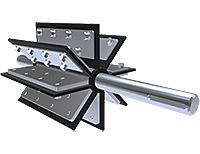
A pressure blower pushes material from one end of your conveying line to the other, much like a heart pumping blood through a system of veins — or that guy in Mad Max who keeps the convoy moving with his pyrotechnic guitar skills.
When you’re transporting dry bulk materials down a dilute-phase pressure pneumatic conveying system, the pressure blower — or positive displacement (PD) blower— gets material from point A to point B efficiently without creating environmental dust.
Sizing your pressure blower package can be a bit tricky, so we came up with a few guidelines to get you started. To get the best possible results, we highly recommend working with a company that specializes in the design and manufacture of pneumatic conveying systems.
Why find the right fit?
Conveying lines come in all different sizes and configurations. Materials also come in different forms: they can be dense or loosely-packed, hot or cool, sticky or coarse. Your system has several key characteristics that affect the air flow rate and pressure levels needed to properly convey your dry bulk materials.
A pressure blower package that works well for one system could create problems or inefficiencies in another. For instance, pipe blockages in your conveying line typically means the blower package is too small. An undersized blower package also makes it difficult to achieve the proper rate of material flow.
Key requirements to size
To size your pressure blower package as accurately as possible, it helps to provide a sketch or drawing of the system layout. You could also have an experienced consultant visit you onsite to determine your application requirements.
Beyond that, these are some specifics you’ll need to properly size a blower:
- The length of the piping, including all horizontal and vertical pipe runs.
- The number of radius elbows that connect the pipe runs in your system.
- The material you’re conveying, plus its characteristics — i.e. the moisture, temperature and abrasiveness.
- The required rate of material per hour.
- The material’s weight or bulk density. This helps determine the pickup velocity and pressure needed to convey the material along the entire length of the system.
- What equipment you’re using to introduce the material (typically a silo or hopper).
- What equipment serves as the destination for conveyed material.
With these design parameters in mind, you’ll be able to select the right blower package size — one that will provide the right amount of air (CFM) and pressure (PSI) to move the material efficiently.
Blower tips and tricks
Aside from sizing, there are a few things you can do to improve the way your blower moves air through the system. First, motor size is critical — keep an eye on your brake horsepower. You can also boost efficiency by making the piping route as direct as possible. To that end, try reconfiguring your system by removing all angled piping and minimizing the number of radius elbows in your system.
If you’re concerned about the noise level, sound enclosures will help, as well as inlet and outlet silencers. Another crucial accessory is the pressure relief valve, which relieves pressure from your blower to prevent damage.
Done and dusted
Ready to start sizing? With pneumatic conveying experts on your side, it couldn’t be easier to choose the right pressure blower package. Contact ACS Valves to get started.


